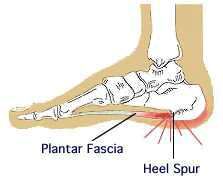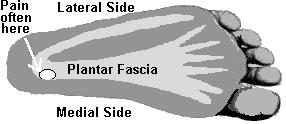|
Heel PainsHeel pains are caused by a wide variety of factors. Things such as poorly fitting shoes, obesity, genetic abnormalities and injury can all be responsible for its onset. The most common types are plantar fasciitis and heel spurs, and they are not necessarily one-and-the-same.
With plantar fasciitis and heel spurs, it is very possible to have one without the other. It has been shown that a vast number of people can be walking around with heel spurs that are not symptomatic, and therefore never need any formal treatment. It is somewhat less common to find people with chronic plantar fasciitis who do not have a spur associated with it.

If you’ve ever complained of heel pains when walking barefoot, or have had that burning pain when you get up in the morning and take those first, painful steps of the day, you may be suffering from one or both of these conditions.
So just what are these conditions? Read on…
Plantar Fasciitis:One of the most common types of heel pains and ailments is plantar fasciitis. It is often seen in conjunction with heel spurs. Occasionally, it is mistakenly referred to as “heel spurs” when in fact the plantar fasciitis is what is causing the pain. Plantar fasciitis typically occurs at the insertion point of the fascia to the under-surface of the calcaneus (heel bone). Severe cases of this can lead to significant disability because weight bearing is so intensely painful. Symptoms can include extreme pain with stepping when getting out of bed in the morning, to pain with walking barefoot. Heel Spurs:Heel spurs are formations of excess bone along a ridge on the under-surface of the calcaneus, at the point where the plantar fascia inserts. In cases of chronic inflammation, these spurs can become fairly large, causing pain when walking, especially without proper shoe support and padding. Walking barefoot with heel spurs can often lead to worsening of the condition, making it all but impossible to walk without pain and limping. Heel spurs can be produced in conjunction with chronic plantar fasciitis because of long-term, repeated tension and tissue inflammation at the insertion of the tissue onto the calcaneus (heel bone). Heel spurs are readily visible on x-rays and can be present without any symptoms,and are often seen as an incidental finding.

Let’s first look at the anatomy of the under-surface, or plantar surface, of the foot. Simply put, the plantar fascia is a large band of tissue that stretches from the metatarsal heads (balls of the foot) back to the underside of the calcaneus, or heel bone. It is an integral structure in the formation of the arch of the foot.
Inflammation can be of a various levels of severity. Severe and/or chronic plantar fasciitis, with or without spurs, can lead to partial tearing of the tissue away from the bone, causing severe pain and disability. Many people describe the discomfort as if one were walking with a “stone” in their shoe.
Retro-Calcaneal BursitisRetro-Cacaneal Bursitis is an inflammatory condition of the posterior (back-side) of the heel. The retro-calcaneal bursa is a small, fluid-filled sac that acts as a cushion and buffer between the calcaneus (heel bone) and the Achilles tendon. This bursa acts as a cushion and lubricant between tendons and muscles sliding over bone. There are bursae around most large joints in the body, including the ankle. Repeated, or excessive, use of the ankle can cause this bursa to become irritated and inflamed. Possible causes are too much walking, running, or jumping and all can be sources of considerable heel pains. Retro-calcaneal bursitis can frequently be associated with a condition known as: "Haglund's Deformity of "Hatchet Heel" in which case there is a measure of bone spur formation at the uppermost portion of the back of the heel. For you women out there, this is often called a "pump bump" because of the history of women getting this bursitis from wearing "pumps"; a mid-high-heel shoe.
Leave Heel Pains; return to Home Page
|

"We hope you enjoy your journey through Bone and Joint Pain.com"

 The most common location for plantar fasciitis to occur is at the insertion of the band of fascia to the calcaneus.
The most common location for plantar fasciitis to occur is at the insertion of the band of fascia to the calcaneus.
